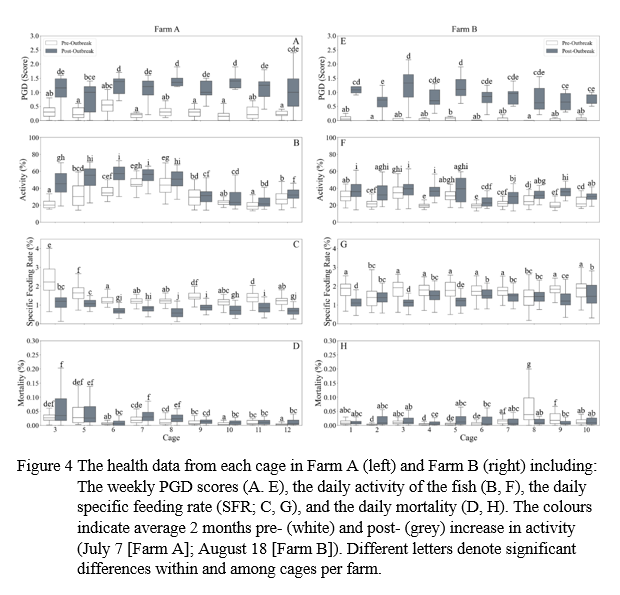USING A MACHINE LEARNING ALGORITHM TO ASSESS ATLANTIC SALMON Salmo salar BEHAVIOUR IN RELATION TO GILL HEALTH IN COMMERCIAL AQUACULTURE FARMS
Introduction
Aquaculture continues its global expansion, reaching a record production of 130.9 million tonnes in 2022, valued at USD 312.8 billion (FAO, 2024). As the industry grows, more sophisticated technology is needed to monitor farms and ensure their sustainability. Using behaviour as a non-invasive monitoring tool, particularly when combined with artificial intelligence (AI) and machine learning, offers new opportunities for real-time farm management and improved welfare outcomes (Feng et al., 2024). The growing adoption of computer vision has further enabled the use of cameras and image-based systems with algorithms to extract and analyse behavioural data in a non-invasive and cost-effective manner (Georgopoulou et al., 2021). These technologies allow for continuous observation of fish, providing insight into group dynamics in commercial farms that are otherwise difficult to monitor.
Building on a preliminary study conducted in 2023 (Burke et al., 2025; Burke et al., in prep) , which identified behavioural changes associated with poor gill health in Atlantic salmon across 2 Scottish farms, the present study aims to further investigate the relationship between group behaviour and gill health in commercial sea cages. This expanded research includes additional sites across Scotland and integrates a broader range of welfare indicators to corroborate these past findings. It also explores potential contributing factors to gill health issues (e.g. environmental parameters, harmful plankton, micro-jellyfish ) to better understand variation in onset across cages and farms.
Methods
In the preliminary study, cameras were deployed at 2 Scottish Atlantic salmon farms. C ages at each farm had a camera used for feeding located in the centre of the cage at mid-depth. An algorithm was created by Observe Technologies to process video footage from these cameras and transform it into behavioural data, termed ‘activity’, which encompasses fish abundance, speed, and shoal cohesion. Daily validation occurred for the duration of the study, whereby experts compare the videos to output from the algorithm. Additionally, gill health scores were evaluated weekly at both sites through the visual sampling of 10 fish in each cage (0 = healthy gills, 5 = necrotic tissue). During the summer 2023, gill health issues arose at both farms, leading to fish stress which was evident in the behavioural data. For the present study, cameras with the algorithm were deployed at 9 additional farms which consisted of between 10-14 stocked cages. Along with the gill health scores recorded by the farmers, the AGD histopathology results, operational welfare indicators, feeding and environmental parameters (e.g. temperature, oxygen, plankton, jellyfish) will be analysed.
Results and Discussion
Preliminary findings from an earlier phase of this project demonstrated a potential relationship between group-level behavioural patterns (activity) and gill health in Atlantic salmon (Fig. 1). This as also associated with decreased feeding rate and increased mortality.
The current study expands on this by incorporating additional sites. It is anticipated that consistent changes in behavioural metrics such as activity and spatial cohesion will be observed in association with deteriorating gill condition. If confirmed, these findings will support the development of real-time, non-invasive welfare indicators. Final results will be available for presentation and discussion at the conference.
References
Burke M , Nikolic D, Fabry P, Rishi H, Telfer T, Rey Planellas S. 2025. Precision Farming in Aquaculture: Non-invasive monitoring of Atlantic salmon ( Salmo salar) behaviour in response to environmental conditions in commercial sea cages for health and welfare assessment . Frontiers in Robotics and AI . 1574161.
Burke M, Nikolic D, Fabry P, Rishi H, Telfer T, Rey Planellas S . Precision Farming in Aquaculture: Assessing gill health in Atlantic salmon ( Salmo salar) using a non-invasive, AI-driven behavioural monitoring approach in commercial farms. In p reparation.
FAO. 2024. The State of World Fisheries and Aquaculture 2024 – Blue Transformation in action. Rome.
Feng J-X, Li P, Liu Y, Liu L, Li Z-H. 2024. A latest progress in the study of fish behavior : cross-generational effects of behavior under pollution pressure and new technologies for behavior monitoring. Environmental Science and Pollution Research 31:11529–11542.
Georgopoulou DG, Stavrakidis -Zachou O, Mitrizakis N, Papandroulakis N. 2021. Tracking and analysis of the movement behavior of European seabass (Dicentrarchus labrax ) in aquaculture systems. Frontiers in Animal Science 2.
